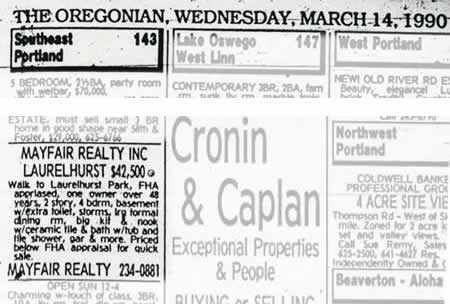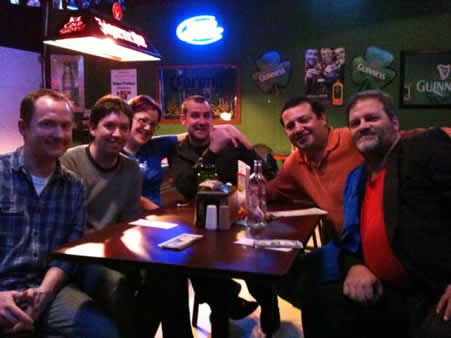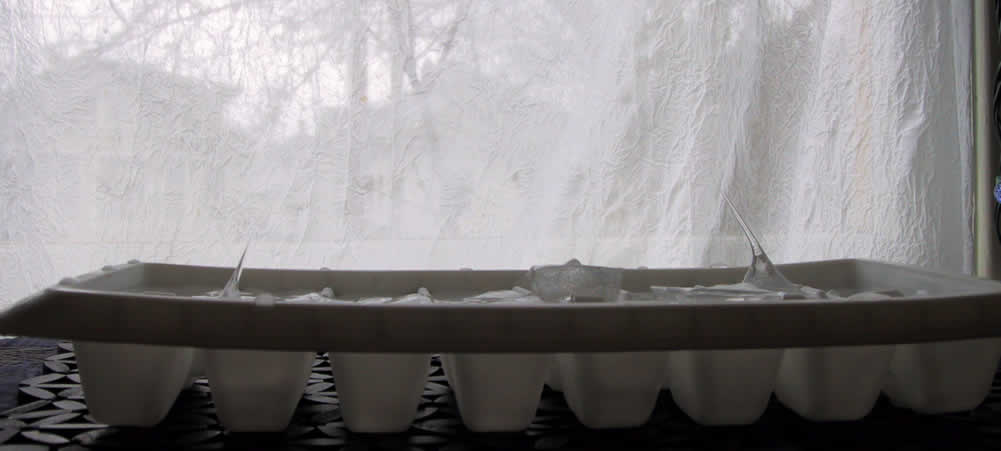
Twenty years ago today I was taking a short leave from my job at Powell’s Books (where I was the desktop publishing guy doing the maps, signage, and ad design) to finish my undergraduate thesis at Reed College. I’d been working full-time at Powell’s and additionally putting in some extra hours in a variety of capacities on campus since I’d returned to school in 1987: first as a “t-watcher” in the computer (terminal) labs, doing book returns for the bookstore, and — on this particular day — working on the Reed News weekly in the school’s Publications Office.
Despite the fact that our jobs at Powell’s paid very, very little, I’d gotten antsy about finding a house to buy at the beginning of my thesis year. The rental Barbara and I (and her sister Lori, and our cats, and Lori’s cats, and Lori’s dogs) had been living in was up for sale, and although it had been on the market without result several times before (one time, Barbara’s landlady had told her she’d accept a used couch as down payment if she wanted to buy the place), real estate in Portland was starting to pick up from the late-’80s doledrums of the Reagan/Bush years and I was worried that we’d be caught short having our home sold out from under us without any place to go while I was trying to finally graduate from college. So we started searching in the winter of 1989/1990.
We started working — if you can call it that — with a real estate agent who we didn’t realize until a few years later had been a high school classmate of Barbara’s. She was useless, steering us toward houses far outside the area we were hoping to buy into (i.e. somewhere near the Sunnyside neighborhood between Hawthorne and Laurelhurst where we were living). A couple of times we’d met with her and toured a place and given her the go-ahead to make an offer only to find out that the house had closed before we’d even set foot inside. In at least one case, that turned out not to be so bad, as the house next door to the one we tried to make an offer on ended up on the cover of Willamette Week as a notorious drug house the cops hadn’t been able to shut down for years. But we didn’t know that at the time, and it was stressful going through the process over and over, particularly as Barbara was having to cobble together the financing from our rather shaky budgetary situation.
We were forced to take the initiative ourselves, looking for signs in the neighborhood, checking out listings, looking at houses ourselves. So it was on a Wednesday morning as I got settled into my temporary desk in Eliot Hall that I made a quick scan through the Oregonian’s real estate classified section.
It was a very different market in Portland at that time. Prices were far lower, but so were the number of listings. Given the changes newspaper classified advertising has gone through over the past two decades, strict comparisons are difficult, but the Wednesday paper of March 14, 1990 had a grand total of two home listings in the West Portland section. The section for Southeast Portland had eleven, several of which were pitched as “good income producers” or duplexes meant to be “owner-occupied.” Then there was this:
LAURELHURST $42,500
Walk to Laurelhurst Park, FHA appriased [sic], one owner over 48 years, 2 story, 4bdrm, basement w/extra toilet, storms, lrg formal dining rm, big kit & nook w/ceramic tile & bath w/tub and tile, shower, gar & more. Priced below FHA appraisal for quick sale.
The rental house we lived in was itself just four blocks from Laurelhurst Park (closer than most of the homes in the Laurelhurst neighborhood, in fact). The price was in the lower range for the neighborhood, meaning it was almost within our reach if you looked at our finances with rose-colored glasses. I got on the phone with the realtor immediately to find out the address — it was only three blocks from our rental — and since I was going to be working or in class until the afternoon, Barbara called Lori at home to get her to take a look at the outside. She said it looked OK to her.
I arranged to meet the owner that afternoon. Frida Rasmussen was 80, had heart problems, and on doctor’s advice she was planning to move into an apartment. She’d been living in the house since 1942 — alone since her husband had died twenty-five years earlier — and while early on she’d added some things like the tile to the bathroom and kitchen, a lot of the subsequent work on the place was necessarily done on the cheap. But we fell in love with the place. Best of all, since we were neighborhood people, Frida knew us by sight, particularly Lori, who regularly walked through the area with her Sheltie, Rebecca, who was particularly distinctive because a horse kick had left her hind legs useless and she used a cart to get around for years. Barbara was smitten with the place when she saw it that evening. Despite the bad roof (how bad we weren’t to find out until the following year when Barbara and I replaced it ourselves), Frida’s extensive use of a bilious color called Monsoon Green for all trim and many other painted surfaces, asbestos shingle siding that was cracked and falling off in many spots, the dropped ceilings with acoustic tile, etc., the fact is that at the level of housing we were looking at, those were the norm for pretty much every house.
Our enthusiasm for the place may have been our saving grace. Barbara didn’t like the greenish-gold carpet in the living and dining rooms or the gray weave thing on the floor in the fourth “bedroom” (what we call The Situation Room, which has entrances to the stairs, the bathroom, the back hall, my office, and the living room) or the then-thirty-year-old gold wallpaper in the living room, but her love of the location and the house and her common decency kept her from making the mistake of the other potential buyers who walked through the house talking about how they’d rip out this or that thing Frida had spent her hard-earned money on. Our offer went in at $45,000, and Frida took it, despite her having to wait a bit longer for the deal to close.
It was a long road from March 14 to mid-June, when Barbara and Lori finally moved into the house. It took an FHA loan (at 11%) to get us in, and we had to make a number of temporary improvements to pass the inspection. The roof was an immediate issue, as Barbara found out when she went up to do some tarring on the bodged-together “gutters” and her butt went through some of the shingles. A basement window with dry rot was replaced with glass bricks. As it turned out, my concerns about having the rental sold out from under us were correct, and we ended up clearing the last of our stuff out of there in the afternoon following my graduation ceremony at Reed, which featured Oregon Symphony conductor James DePriest and a torrential rainfall. The funeral for my father’s step-father was the week before graduation. Barbara did the heavy lifting to get the financing taken care of, since the down payment on the house consisted mostly of the few thousand her mother had left Lori and Barbara when she’d died a year and a half before.
Frida needed the money from the sale before she could afford down payment on an apartment, and there were several weeks after we had to move out of the rental before the deal on the house closed. We and the menagerie needed someplace to stay. Frida liked us but hated cats and she had no obligation to let us move in before final closing (although she did let us move some stuff into the garage). Barbara’s father hates all animals and though he had the space in his house in southwest Portland, refused to let his daughters bring them. We ended up moving out to my grandmother Margaret’s farm in Gresham (she was away for a time after her husband died), putting the cats into a cat hotel we could ill-afford, but the neighbor who cut the front yard for my grandmother drove over the septic tank field with his tractor and all of the drains started backing up. Barbara’s friend Paula came through and let us stay with her for the duration. Oh, did I mention that before we could take possession of the house I left town for a seven-week summer program at New York University?
So, today’s not the 20th anniversary of the day we moved in. Barbara moved in on a different day than I did — I wasn’t back from New York City until July — but it is the day that we first saw our house as a potential home. It’s a day to celebrate a certain amount of luck; not to mention probably one of the best decisions I’m ever likely to make (i.e. “Despite the fact that we’re broke we have to buy a house now!”) because there’s probably no way we’d be able to afford to buy into this neighborhood today. In the twenty years we’ve been here, it’s gone from a neighborhood with skinheads, heroin addicts shooting up at the abandoned Foremost Dairy, and condemned houses across the street with squatters and guys peeing off the porch in the morning to a pretty uneventful middle-class community (albeit one with a methadone treatment center half a mile down the road).
Thanks on this anniversary to everyone who helped make our little home possible.





